
|
It brightened up to 3.7 mag and became a naked eye comet in mid January (Jan. 13, Marek Biely). Now it is fading. But it is bright as 6.4 mag still now (Mar. 25, Carlos Labordena). In the Northern Hemisphere, it keeps observable all night until July when the comet will fade down to 13 mag. It is not observable in the Southern Hemisphere.
Date(TT) R.A. (2000) Decl. Delta r Elong. m1 Best Time(A, h)
Mar. 28 1 23.36 64 17.0 1.725 1.543 62 6.8 19:24 (149,-34)
Apr. 4 1 23.80 66 43.3 1.813 1.601 61 7.1 19:15 (152,-36)
|
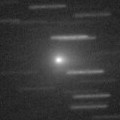
|
Now it is very bright as 8.8 mag (Mar. 25, Alexandre Amorim). In the Southern Hemisphere, it keeps observable in good condition for a long time until the comet fades out. In the Northern Hemisphere, it keeps extremely low and hard to observe until June. It will be observable in good condition after June while the comet will be fading gradually.
Date(TT) R.A. (2000) Decl. Delta r Elong. m1 Best Time(A, h)
Mar. 28 21 27.10 -17 38.0 1.805 1.362 48 8.9 4:45 (271, 30)
Apr. 4 21 51.47 -15 51.6 1.783 1.359 49 8.8 4:50 (268, 31)
|
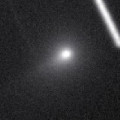
|
Bright new comet. Now it is so bright as 9.5 mag (Mar. 18, Sandor Szabo). In the Northern Hemisphere, it keeps locating extremely low and hard to observe. It will be getting higher gradually after May, but the comet will be fainter than 14 mag. It is not observable after this in the Southern Hemisphere.
Date(TT) R.A. (2000) Decl. Delta r Elong. m1 Best Time(A, h)
Mar. 28 1 15.00 19 37.2 1.707 0.852 20 10.4 19:24 (103,-18)
Apr. 4 1 19.18 25 54.9 1.787 0.933 21 11.0 19:15 (107,-23)
|

|
Bright new comet. Now it is so bright as 10.3 mag (Mar. 26, Alan Hale). It seems to be a fragment of Comets C/1988 A1 (Liller) and C/1996 Q1 (Tabur). It must have been visible bright in the evening sky from December to February in the Northern Hemisphere, but it was not discovered. It will be fading after this. But it is observable in excellent condition in the Northern Hemisphere. In the Southern Hemisphere, it is not observable until June.
Date(TT) R.A. (2000) Decl. Delta r Elong. m1 Best Time(A, h)
Mar. 28 23 51.17 47 17.3 1.265 0.904 45 10.6 4:45 (232,-32)
Apr. 4 23 55.65 55 2.9 1.197 0.960 50 10.7 4:50 (222,-30)
|
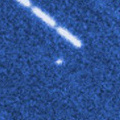
|
Now it is 12.8 mag (Mar. 21, Michael Mattiazzo). It will brighten up to 10.5 mag in May and June, but it is not observable. In the Northern Hemisphere, it will be observable after autumn while the comet will be fading.
Date(TT) R.A. (2000) Decl. Delta r Elong. m1 Best Time(A, h)
Mar. 28 1 31.32 -6 2.6 2.437 1.526 18 12.0 19:24 ( 83, 0)
Apr. 4 1 49.39 -2 59.8 2.418 1.491 16 11.8 19:15 ( 86, -1)
|
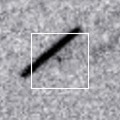
|
It will brighten up to 11 mag in April and May. But the condition is bad in this apparition. In the Southern Hemisphere, it will become observable in the morning extremely low sky after late April. It will not be observable until late July in the Northern Hemisphere.
Date(TT) R.A. (2000) Decl. Delta r Elong. m1 Best Time(A, h)
Mar. 28 23 24.35 -7 42.9 2.304 1.393 18 12.1 4:45 (279, 0)
Apr. 4 23 47.05 -6 24.3 2.312 1.412 19 11.9 4:50 (277, 2)
|
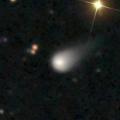
|
It brightened up to 13.6 mag until the end of 2014, brighter than originally expected (Dec. 19, Chris Wyatt). It is expected to brighten up to 4 mag from autumn to winter. In the Southern Hemisphere, it is getting higher gradually in the morning sky. In the Northern Hemisphere, it is hardly observable until 2015 December.
Date(TT) R.A. (2000) Decl. Delta r Elong. m1 Best Time(A, h)
Mar. 28 23 10.10 -21 40.2 4.347 3.524 30 12.2 4:45 (289, 11)
Apr. 4 23 14.93 -21 37.3 4.205 3.444 35 12.0 4:50 (285, 17)
|
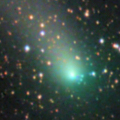
|
It brightened up to 9 mag from autumn to winter in 2014. Now it is fading. It has already faded down to 14.6 mag (Mar. 28, Todd Augustyniak). In the Northern Hemisphere, it will be observable in excellent condition after this while the comet will be fading. In the Southern Hemisphere, it is hardly observable after this.
Date(TT) R.A. (2000) Decl. Delta r Elong. m1 Best Time(A, h)
Mar. 28 17 20.28 42 36.5 2.142 2.514 99 12.2 4:45 (183, 12)
Apr. 4 17 1.87 46 40.5 2.154 2.586 104 12.3 4:15 (180, 8)
|
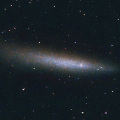
|
The spacecraft observed it brightened rapidly from 9 mag up to 2 mag when passing near by the sun. The nucleus has been already disintegrated, but the remnant was visible bright also on the earth (Mar. 7, Juan Jose Gonzalez). Now it is fainter than 10.3 mag (Mar. 17, Marek Biely). It locates high in the evening sky in the Northern Hemisphere. It is not observable in the Southern Hemisphere.
Date(TT) R.A. (2000) Decl. Delta r Elong. m1 Best Time(A, h)
Mar. 28 3 2.27 48 10.6 1.381 1.177 56 12.4 19:24 (140,-14)
Apr. 4 3 39.02 50 31.4 1.570 1.328 57 13.2 19:15 (144,-13)
|
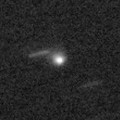
|
It will approach to the sun down to 0.3 a.u. in 2015 July, and it is expected to be bright. It brightened up to 15.6 mag in January (Jan. 13, Yasukazu Ikari). In the Southern Hemisphere, it is hard to observe for a while after this. But it will be observable after mid July, and keeps observable while the comet will be fading gradually. It will not be observable after this in the Northern Hemisphere.
Date(TT) R.A. (2000) Decl. Delta r Elong. m1 Best Time(A, h)
Mar. 28 0 13.97 -5 48.8 3.089 2.109 8 13.2 4:45 (285,-11)
Apr. 4 0 24.09 -3 58.8 2.969 1.999 11 12.9 4:50 (280, -7)
|
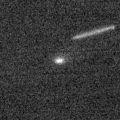
|
Now it is 15.5 mag (Mar. 1, Taras Prystavski). It is expected to brighten rapidly and will be observable in good condition at 13 mag from March to May.
Date(TT) R.A. (2000) Decl. Delta r Elong. m1 Best Time(A, h)
Mar. 28 17 32.00 -19 32.8 0.502 1.216 103 13.7 4:45 (203, 73)
Apr. 4 18 8.14 -19 0.3 0.483 1.196 101 13.5 4:50 (205, 73)
|
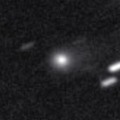
|
Now it is 14.3 mag (Mar. 1, Taras Prystavski). In 2015, it keeps 13-14 mag and will be observable in good condition for a long time.
Date(TT) R.A. (2000) Decl. Delta r Elong. m1 Best Time(A, h)
Mar. 28 18 55.03 -11 35.5 3.431 3.458 83 13.6 4:45 (234, 56)
Apr. 4 19 1.70 -11 10.9 3.339 3.457 88 13.5 4:50 (224, 59)
|

|
Now it is so faint as 16.8 mag (Mar. 16, Tsutomu Seki).
Date(TT) R.A. (2000) Decl. Delta r Elong. m1 Best Time(A, h)
Mar. 28 17 56.10 -31 11.8 5.845 6.057 97 13.7 4:45 (255, 78)
Apr. 4 17 57.35 -31 18.0 5.733 6.055 104 13.7 4:50 (230, 84)
|

|
It brightened up to 6.9 mag in 2014 autumn (Oct. 17, Marco Goiato). Now it is fading. But it is bright as 12.6 mag still now (Feb. 9, Chris Wyatt). In the Southern Hemisphere, it is unobservable temporarily now, but it will be observable in good condition again after mid April. It will be observable again in mid June also in the Northern Hemisphere.
Date(TT) R.A. (2000) Decl. Delta r Elong. m1 Best Time(A, h)
Mar. 28 0 35.00 -18 26.0 4.101 3.192 21 13.9 19:24 ( 65, -3)
Apr. 4 0 38.30 -17 55.2 4.162 3.269 23 14.0 4:50 (293, -2)
|
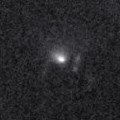
|
Now it is 15.2 mag and visible visually (Mar. 18, Sandor Szabo). It will brighten up to 11 mag in 2015 autumn. In this apparition, it is observable until the highlight while the comet is brightening.
Date(TT) R.A. (2000) Decl. Delta r Elong. m1 Best Time(A, h)
Mar. 28 12 58.77 1 42.6 1.505 2.495 170 14.5 0:40 (180, 53)
Apr. 4 12 52.79 2 32.9 1.458 2.453 172 14.3 0:07 (180, 53)
|
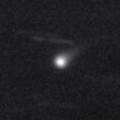
|
It brightened very rapidly. Now it is so bright as 14.6 mag and visible visually (Mar. 17, Sandor Szabo). It keeps 14-15 mag for a while after this. In the Northern Hemisphere, it will be getting lower gradually after May, and will be unobservable in mid June. In the Southern Hemisphere, it will be getting lower gradually after June, and will be unobservable in early August.
Date(TT) R.A. (2000) Decl. Delta r Elong. m1 Best Time(A, h)
Mar. 28 8 45.79 10 1.7 2.823 3.480 123 14.4 20:24 (180, 45)
Apr. 4 8 46.63 9 52.2 2.896 3.472 117 14.4 19:57 (180, 45)
|
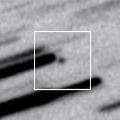
|
It passed the perihelion on Mar. 15, and it must have brightened up to 13 mag. But it is not observable until it becomes fainter than 18 mag.
Date(TT) R.A. (2000) Decl. Delta r Elong. m1 Best Time(A, h)
Mar. 28 23 50.29 6 35.2 1.417 0.462 9 14.4 4:45 (271,-13)
Apr. 4 0 15.80 11 7.9 1.590 0.632 10 15.2 4:50 (266,-14)
|
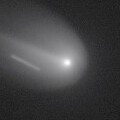
|
It brightened up to 7-8 mag in outburst twice from December to January. Now it is fading. It has already faded down to 13.4 mag (Mar. 16, Catalina Sky Survey). In the Northern Hemisphere, it will be getting lower gradually after this, and will be unobservable in late May. In the Southern Hemisphere, it keeps locating extremely low after this.
Date(TT) R.A. (2000) Decl. Delta r Elong. m1 Best Time(A, h)
Mar. 28 3 34.01 24 26.8 2.017 1.581 50 14.5 19:24 (126, 6)
Apr. 4 3 56.99 25 39.8 2.123 1.648 48 15.1 19:15 (127, 6)
|
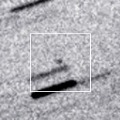
|
It must have brightened up to 11 mag from January to February, but no observations have been reported. Now it is 16.3 mag (Mar. 29, A. Maury, J.-F. Soulier, J.-G. Bosch, T. Noel). In the Southern Hemisphere, it is observable in the morning sky after this while the comet will be fading. It is hardly observable in the Northern Hemisphere.
Date(TT) R.A. (2000) Decl. Delta r Elong. m1 Best Time(A, h)
Mar. 28 22 37.80 -18 38.8 2.129 1.415 33 14.6 4:45 (282, 16)
Apr. 4 22 59.85 -17 41.3 2.145 1.456 35 14.6 4:50 (280, 18)
|
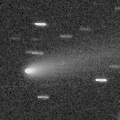
|
Now it is 13.5 mag (Mar. 14, Chris Wyatt). It is fainter than originally predicted by 2 mag. It will be fading gradually after this. But it keeps observable in good condition for a while.
Date(TT) R.A. (2000) Decl. Delta r Elong. m1 Best Time(A, h)
Mar. 28 11 19.58 20 22.3 1.524 2.450 151 14.6 22:57 (180, 35)
Apr. 4 11 16.03 19 58.9 1.593 2.483 145 14.8 22:26 (180, 35)
|
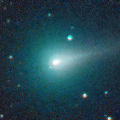
|
It brightened up to 10.6 mag from autumn to winter (Nov. 29, Seiichi Yoshida). Now it is 12.4 mag (Feb. 19, Taras Prystavski). It will be fading graudually after this. But it keeps observable for a long time until the comet fades out.
Date(TT) R.A. (2000) Decl. Delta r Elong. m1 Best Time(A, h)
Mar. 28 17 38.87 -14 34.6 1.816 2.244 101 14.8 4:45 (203, 68)
Apr. 4 17 41.13 -14 35.1 1.801 2.316 108 15.0 4:50 (183, 70)
|
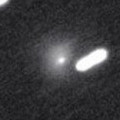
|
Very far object. However, outburst occured on Feb. 20, and now it brightened up to 15.3 mag (Feb. 28, Taras Prystavski). It is reported so bright visually as 12.5 mag (Mar. 22, Marco Goiato). It locates high in the Southern Hemisphere. But it locates somewhat low in the Northern Hemisphere.
Date(TT) R.A. (2000) Decl. Delta r Elong. m1 Best Time(A, h)
Mar. 28 12 11.22 -23 11.1 8.210 9.150 159 15.2 23:49 (180, 78)
Apr. 4 12 9.29 -22 55.0 8.203 9.148 159 15.2 23:19 (180, 78)
|

|
It brightened up to 11-12 mag in 2012. It has already faded down to 16.0 mag (Feb. 14, Taras Prystavski). It keeps observable at 15 mag in good condition until summer.
Date(TT) R.A. (2000) Decl. Delta r Elong. m1 Best Time(A, h)
Mar. 28 11 22.54 -7 35.7 8.250 9.212 163 15.2 23:00 (180, 63)
Apr. 4 11 18.55 -7 10.1 8.320 9.249 157 15.2 22:28 (180, 62)
|
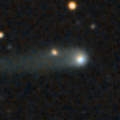
|
Now it is 15.3 mag (Jan. 7, Taras Prystavski). It keeps 15 mag for a long time from 2014 to 2015. It is observable in excellent condition in 2014 in the Southern Hemisphere, or in 2015 in the Northern Hemisphere. It becomes unobservable temporarily from March to May.
Date(TT) R.A. (2000) Decl. Delta r Elong. m1 Best Time(A, h)
Mar. 28 1 2.38 3 48.1 4.865 3.884 9 15.3 19:24 ( 87,-11)
Apr. 4 1 8.00 5 21.2 4.883 3.887 4 15.3 19:15 ( 87,-15)
|
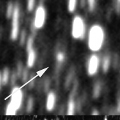
|
Distant object, but it keeps observable at 14-15 mag for a long time from 2015 to 2016. However, no observations have been reported since 2014 December.
Date(TT) R.A. (2000) Decl. Delta r Elong. m1 Best Time(A, h)
Mar. 28 20 59.07 -4 4.4 6.317 5.755 51 15.6 4:45 (254, 28)
Apr. 4 21 3.85 -3 40.6 6.208 5.730 57 15.5 4:50 (249, 33)
|

|
Now it is 14.7 mag (Mar. 2, Taras Prystavski). It is observable at 15-16 mag in good condition in 2015.
Date(TT) R.A. (2000) Decl. Delta r Elong. m1 Best Time(A, h)
Mar. 28 19 0.47 -17 55.4 7.603 7.536 82 15.6 4:45 (244, 59)
Apr. 4 18 59.78 -18 12.2 7.508 7.565 89 15.6 4:50 (233, 65)
|
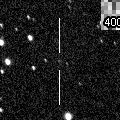
|
It brightened rapidly. Now it is 16.1 mag, much brighter than origianlly predicted (Feb. 14, Taras Prystavski). However, it will fade out rapidly after this.
Date(TT) R.A. (2000) Decl. Delta r Elong. m1 Best Time(A, h)
Mar. 28 16 12.97 -25 51.9 0.919 1.666 120 15.7 3:54 (180, 81)
Apr. 4 16 19.22 -27 42.0 0.904 1.695 125 15.9 3:32 (180, 83)
|
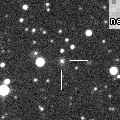
|
Now it is 15.4 mag and visible visually (Mar. 18, Sandor Szabo). In the Northern Hemisphere, it keeps 15-16 mag and observable in excellent condition until early summer. It locates somewhat low in the Southern Hemisphere.
Date(TT) R.A. (2000) Decl. Delta r Elong. m1 Best Time(A, h)
Mar. 28 13 12.82 34 29.1 2.988 3.817 141 15.7 0:54 (180, 21)
Apr. 4 13 7.26 34 3.2 3.019 3.842 140 15.7 0:21 (180, 21)
|

|
First return of a comet re-discovered after 112-year blank in 2008. It brightened up to 12 mag in 2008. It is expected to brighten up to 15 mag from spring to summer in this apparition. It keeps locating low in the morning sky for a while.
Date(TT) R.A. (2000) Decl. Delta r Elong. m1 Best Time(A, h)
Mar. 28 21 50.05 -3 38.9 2.257 1.613 39 15.9 4:45 (262, 17)
Apr. 4 22 10.50 -2 11.1 2.212 1.592 40 15.8 4:50 (259, 19)
|

|
Now it is 14.8 mag and visible visually (Mar. 18, Sandor Szabo). It will pass close to the earth from spring to summer in 2016, and it is expected to be observable at 6-7 mag in good condition. It will be unobservable soon in the Southern Hemisphere. In the Northern Hemispehre, it will be getting lower gradually and will be unobservable temporarily in mid May.
Date(TT) R.A. (2000) Decl. Delta r Elong. m1 Best Time(A, h)
Mar. 28 4 44.85 33 53.6 5.183 4.895 67 16.0 19:24 (143, 9)
Apr. 4 4 44.96 33 43.1 5.232 4.829 61 15.9 19:15 (140, 7)
|

|
Now it is 15.7 mag (Mar. 31, MASTER-SAAO Observatory). It is expected to brighten up to 12 mag from July to August. In the Southern Hemisphere, it keeps observable in good condition until summer. In the Northern Hemisphere, it will be getting higher gradually after May, and will be observable in good condition after summer.
Date(TT) R.A. (2000) Decl. Delta r Elong. m1 Best Time(A, h)
Mar. 28 19 44.67 -45 8.1 2.406 2.407 78 16.2 4:45 (301, 58)
Apr. 4 19 57.03 -43 54.8 2.268 2.347 81 16.0 4:50 (299, 62)
|

|
Now it is 17.6 mag (Feb. 23, Mitsunori Tsumura). It will brighten up to 13 mag in 2016. It will be getting lower after this, and will be unobservable in early June. It is fainter than this ephemeris recently.
Date(TT) R.A. (2000) Decl. Delta r Elong. m1 Best Time(A, h)
Mar. 28 6 0.12 27 7.3 2.836 2.894 83 16.2 19:24 (155, 23)
Apr. 4 6 7.02 26 59.5 2.906 2.868 77 16.2 19:15 (152, 22)
|
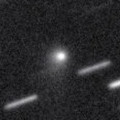
|
Now it is 15.8 mag (Jan. 11, Y. Sugiyama). It keeps observable at 15-16 mag for a long time from 2015 to 2016. In the Northern Hemisphere, it becomes unobservable temporarily from April to June, but it will be observable in good condition after July. It is not observable after this in the Southern Hemisphere.
Date(TT) R.A. (2000) Decl. Delta r Elong. m1 Best Time(A, h)
Mar. 28 3 10.86 33 25.9 5.982 5.387 49 16.2 19:24 (129, -4)
Apr. 4 3 15.06 34 7.0 6.046 5.373 44 16.2 19:15 (128, -7)
|
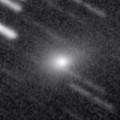
|
It brightened up to 13.8 mag in winter (Feb. 15, Jakub Cerny). Now it is fading. It has already faded down to 15.2 mag (Mar. 17, Space Surveillance Telescope, Atom Site). It will be getting lower after May. It will be unobservable in June in the Northern Hemisphere, or in July in the Southern Hemisphere.
Date(TT) R.A. (2000) Decl. Delta r Elong. m1 Best Time(A, h)
Mar. 28 6 44.96 19 23.4 2.280 2.549 93 16.2 19:24 (163, 34)
Apr. 4 6 52.72 18 58.2 2.378 2.560 88 16.4 19:15 (160, 34)
|
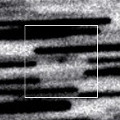
|
Now it is 19.2 mag (Feb. 21, Jean-Francois Soulier). It is expected to brighten up to 15 mag in summer, and will be observable in excellent condition. But it is fainter than this ephemeris.
Date(TT) R.A. (2000) Decl. Delta r Elong. m1 Best Time(A, h)
Mar. 28 20 25.92 -16 38.0 2.039 1.802 62 16.5 4:45 (261, 42)
Apr. 4 20 44.07 -15 26.6 1.972 1.785 64 16.3 4:50 (257, 44)
|
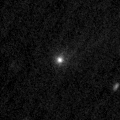
|
Now it is 15.2 mag and visible visually (Mar. 18, Sandor Szabo). It keeps observable in good condition after this, but it will be fading gradually.
Date(TT) R.A. (2000) Decl. Delta r Elong. m1 Best Time(A, h)
Mar. 28 11 58.21 10 57.4 1.387 2.365 164 16.3 23:35 (180, 44)
Apr. 4 11 53.97 11 22.8 1.435 2.392 158 16.4 23:04 (180, 44)
|
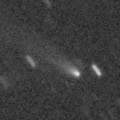
|
Now it is 15.3 mag (Feb. 23, Mitsunori Tsumura). It keeps observable in good condition after this in the Northern Hemisphere, but it will be fading gradually. It locates low in the Southern Hemisphere.
Date(TT) R.A. (2000) Decl. Delta r Elong. m1 Best Time(A, h)
Mar. 28 4 55.32 29 18.5 1.619 1.571 69 16.5 19:24 (143, 14)
Apr. 4 5 20.06 29 44.0 1.699 1.612 67 16.8 19:15 (144, 15)
|

|
Now it is 16.1 mag (Mar. 31, Polonia Observatory). It approaches to the earth, and brightens up to 16 mag from April to May. But it will be fainter than 18 mag in July. It is observable in excellent condition in the Southern Hemisphere. It will be observable in excellent condition after May also in the Northern Hemisphere.
Date(TT) R.A. (2000) Decl. Delta r Elong. m1 Best Time(A, h)
Mar. 28 18 55.79 -49 21.8 0.874 1.292 87 16.8 4:45 (314, 65)
Apr. 4 19 32.27 -45 9.2 0.826 1.258 86 16.6 4:50 (304, 66)
|
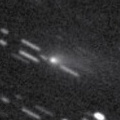
|
It brightened up to 2 mag by unusual major outburst in 2007. It brightened up to 12.6 mag in this apparition (June 25, Taras Prystavski). It faded down to 17-18 mag, but it suddenly brightened in outburst on Jan. 26, and brightened up to 13.2 mag (Jan. 29, Uwe Pilz). Then it is fading rapidly. It has already faded down to 17.2 mag (Feb. 27, A. Diepvens). In the Northern Hemisphere, it keeps observable in good condition. In the Southern Hemisphere, it keeps extremely low.
Date(TT) R.A. (2000) Decl. Delta r Elong. m1 Best Time(A, h)
Mar. 28 5 1.09 37 10.3 3.422 3.251 71 16.6 19:24 (148, 8)
Apr. 4 5 10.44 36 46.1 3.542 3.280 66 17.0 19:15 (146, 8)
|
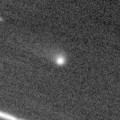
|
Now it is 16.1 mag (Feb. 15, Taras Prystavski). It keeps 17-18 mag for a long time from 2014 to 2016.
Date(TT) R.A. (2000) Decl. Delta r Elong. m1 Best Time(A, h)
Mar. 28 11 50.80 -22 38.4 4.424 5.365 158 16.7 23:27 (180, 78)
Apr. 4 11 40.71 -22 0.0 4.439 5.370 156 16.7 22:50 (180, 77)
|
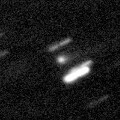
|
Now it is 16.1 mag (Feb. 22, Taras Prystavski). It keeps observable at 16-17 mag in good condition for a while.
Date(TT) R.A. (2000) Decl. Delta r Elong. m1 Best Time(A, h)
Mar. 28 7 54.32 14 8.4 3.686 4.148 110 16.8 19:33 (180, 41)
Apr. 4 7 56.35 14 9.6 3.791 4.156 104 16.9 19:15 (178, 41)
|
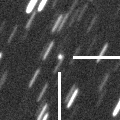
|
Brightened rapidly. Now it is bright as 15.8 mag and visible visually (Mar. 18, Sandor Szabo). It will be brighter than this ephemeris for a while. It is observable in excellent condition in the Northern Hemisphere. It is not observable in the Southern Hemisphere.
Date(TT) R.A. (2000) Decl. Delta r Elong. m1 Best Time(A, h)
Mar. 28 6 57.76 52 48.8 1.686 2.001 92 16.9 19:24 (173, 2)
Apr. 4 7 17.58 51 46.8 1.771 2.032 89 17.1 19:15 (173, 3)
|
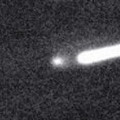
|
It brightened up to 15.5 mag from autumn to winter (Nov. 25, Taras Prystavski). Now it is fading. It has already faded down to 16.6 mag (Feb. 15, Taras Prystavski). It keeps observable in good condition for a while.
Date(TT) R.A. (2000) Decl. Delta r Elong. m1 Best Time(A, h)
Mar. 28 17 47.06 -9 55.7 1.838 2.235 99 17.1 4:45 (204, 63)
Apr. 4 17 52.30 -9 34.6 1.796 2.273 105 17.1 4:50 (189, 64)
|
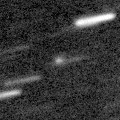
|
Now it is 17.7 mag (Feb. 17, K. Hills). It keeps observable at 17 mag from spring to summer. It locates somewhat low in the Northern Hemisphere.
Date(TT) R.A. (2000) Decl. Delta r Elong. m1 Best Time(A, h)
Mar. 28 17 14.01 -29 5.4 2.708 3.144 106 17.1 4:45 (201, 84)
Apr. 4 17 17.18 -29 5.1 2.619 3.146 112 17.1 4:30 (180, 84)
|
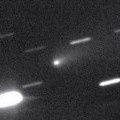
|
Now it is 16.0 mag (Mar. 20, Yasukazu Ikari). It keeps observable for a long time after this while the comet will be fading gradually.
Date(TT) R.A. (2000) Decl. Delta r Elong. m1 Best Time(A, h)
Mar. 28 9 7.35 7 16.5 2.368 3.102 129 17.1 20:45 (180, 48)
Apr. 4 9 7.59 7 44.5 2.486 3.143 122 17.3 20:18 (180, 47)
|
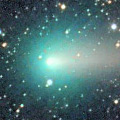
|
It brightened up to 6.5 mag in September (Sept. 21, Marco Goiato). Now it is fading rapidly. It has already faded, fainter than 17.7 mag (Feb. 15, Taras Prystavski).
Date(TT) R.A. (2000) Decl. Delta r Elong. m1 Best Time(A, h)
Mar. 28 14 29.47 22 53.4 2.177 3.013 140 17.2 2:11 (180, 32)
Apr. 4 14 12.37 24 46.3 2.236 3.100 143 17.4 1:27 (180, 30)
|
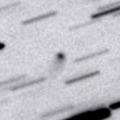
|
Now it is 18.0 mag (Feb. 27, W. Hasubick). It keeps observable at 17-18 mag for a long time from 2013 to 2016. It keeps locating high in the Northern Hemisphere. It keeps locating very low in the Southern Hemipshere.
Date(TT) R.A. (2000) Decl. Delta r Elong. m1 Best Time(A, h)
Mar. 28 17 11.81 59 6.3 6.438 6.633 96 17.3 4:45 (181, -4)
Apr. 4 17 4.92 60 26.3 6.433 6.643 97 17.3 4:18 (180, -5)
|

|
Now it is 17.7 mag (Jan. 20, Taras Prystavski). It was observed at 17 mag in 2014 summer. In the Northern Hemisphere, it is observable at 17.5 mag in excellent condition also in 2015. It is not observable in the Southern Hemisphere.
Date(TT) R.A. (2000) Decl. Delta r Elong. m1 Best Time(A, h)
Mar. 28 21 2.26 40 14.0 4.443 4.023 59 17.3 4:45 (221, -3)
Apr. 4 21 12.03 41 21.2 4.441 4.041 60 17.3 4:50 (217, -1)
|
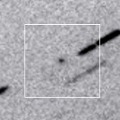
|
Now it is 17.8 mag (Feb. 25, A. Diepvens). It keeps observable after this while the comet will be getting brighter graudually. It will brighten up to 11 mag from autumn to winter. But it locates low at that time.
Date(TT) R.A. (2000) Decl. Delta r Elong. m1 Best Time(A, h)
Mar. 28 14 55.39 2 28.5 1.686 2.548 142 17.6 2:36 (180, 53)
Apr. 4 14 52.74 3 24.5 1.600 2.506 148 17.3 2:06 (180, 52)
|

|
Now it is 17.2 mag (Mar. 24, iTelescope Observatory, Siding Spring). It keeps 17 mag until July. It is observable in excellent condition in the Southern Hemisphere. It locates somewhat low in the Northern Hemisphere.
Date(TT) R.A. (2000) Decl. Delta r Elong. m1 Best Time(A, h)
Mar. 28 16 41.68 -22 54.2 1.959 2.544 114 17.5 4:22 (180, 78)
Apr. 4 16 44.80 -23 9.1 1.882 2.545 120 17.4 3:58 (180, 78)
|
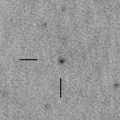
|
Now it is 18.6 mag (Feb. 16, K. Hills). It will brighten up to 14 mag and will be observable in good condition in 2016.
Date(TT) R.A. (2000) Decl. Delta r Elong. m1 Best Time(A, h)
Mar. 28 12 55.93 0 31.9 2.842 3.832 171 17.6 0:37 (180, 55)
Apr. 4 12 51.73 1 7.3 2.803 3.798 173 17.5 0:06 (180, 54)
|
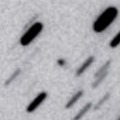
|
Now it is 17.5 mag (Feb. 19, W. Hasubick). It was observed around 17-18 mag in early 2014. It will be observable around 17-18 mag again from 2014 autumn to 2015 spring, in excellent condition in the Northern Hemisphere. It is not observable in the Southern Hemisphere.
Date(TT) R.A. (2000) Decl. Delta r Elong. m1 Best Time(A, h)
Mar. 28 9 56.11 53 33.2 4.735 5.246 115 17.6 21:34 (180, 2)
Apr. 4 9 53.49 52 32.2 4.816 5.258 111 17.6 21:04 (180, 3)
|
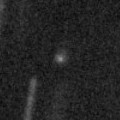
|
Now it is 17.7 mag (Feb. 24, K. Hills). It keeps observable at 17 mag from winter to spring. It is observable in excellent condition in the Southern Hemisphere. But it locates somewhat low in the Northern Hemisphere.
Date(TT) R.A. (2000) Decl. Delta r Elong. m1 Best Time(A, h)
Mar. 28 10 35.36 -30 34.3 2.241 3.089 141 17.7 22:12 (180, 86)
Apr. 4 10 26.59 -31 9.8 2.279 3.092 137 17.7 21:36 (180, 86)
|
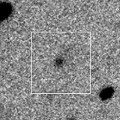
|
It will brighten up to 14 mag in 2016 spring. Now it is 16.9 mag (Feb. 19, W. Hasubick). In 2015, it is observable in good condition until spring in the Northern Hemisphere. In the Southern Hemisphere, it is not observable in 2015. But it will be observable in good condition at the high light in 2016.
Date(TT) R.A. (2000) Decl. Delta r Elong. m1 Best Time(A, h)
Mar. 28 7 16.93 38 11.4 3.627 3.901 98 17.7 19:24 (174, 17)
Apr. 4 7 19.38 37 38.4 3.671 3.844 92 17.7 19:15 (171, 17)
|
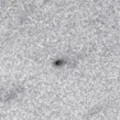
|
Now it is 17.6 mag (Jan. 21, Catalina Sky Survey). Now it is around the aphelion. In the Northern Hemisphere, it is observable at 18 mag in good condition from winter to spring. It locates somewhat low in the Southern Hemisphere.
Date(TT) R.A. (2000) Decl. Delta r Elong. m1 Best Time(A, h)
Mar. 28 8 29.78 29 6.5 4.018 4.536 115 17.7 20:08 (180, 26)
Apr. 4 8 29.53 28 55.0 4.106 4.526 108 17.7 19:40 (180, 26)
|

|
First return of a periodic comet discovered in 1994. Now it is 18.0 mag (Mar. 31, MASTER-SAAO Observatory). It will brighten up to 15 mag from summer to autumn, and will be observable in excellent condition in the Southern Hemisphere. It locates somewhat low in the Northern Hemisphere.
Date(TT) R.A. (2000) Decl. Delta r Elong. m1 Best Time(A, h)
Mar. 28 20 51.89 -33 34.8 3.394 3.053 61 17.9 4:45 (285, 44)
Apr. 4 21 3.85 -33 19.1 3.282 3.018 66 17.8 4:50 (283, 48)
|
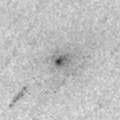
|
It brightened up to 15.4 mag in autumn (Nov. 19, Taras Prystavski). But it was extremely diffuse. It was reported so faint as 20 mag after December. It keeps observable in excellent condition in the Southern Hemisphere. But it locates low in the Northern Hemisphere.
Date(TT) R.A. (2000) Decl. Delta r Elong. m1 Best Time(A, h)
Mar. 28 8 22.65 -36 35.8 2.072 2.652 114 17.8 20:01 ( 0, 88)
Apr. 4 8 25.04 -35 46.4 2.170 2.711 112 18.0 19:36 ( 0, 89)
|

|
Now it is 19.3 mag (Mar. 27, Pan-STARRS 1, Haleakala). It will brighten rapidly, and will be observable at 16.5 mag in good condition from May to July.
Date(TT) R.A. (2000) Decl. Delta r Elong. m1 Best Time(A, h)
Mar. 28 16 10.26 -24 11.7 1.280 1.993 121 18.0 3:51 (180, 79)
Apr. 4 16 17.35 -23 43.9 1.194 1.966 127 17.8 3:30 (180, 79)
|
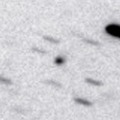
|
Now it is 16.6 mag (Feb. 20, Yasukazu Ikari). It keeps 18 mag from 2014 to 2015. In 2015, it keeps observable in good condition from winter to spring.
Date(TT) R.A. (2000) Decl. Delta r Elong. m1 Best Time(A, h)
Mar. 28 10 31.09 -10 57.1 5.148 6.037 150 17.9 22:09 (180, 66)
Apr. 4 10 28.83 -10 53.9 5.208 6.050 144 17.9 21:39 (180, 66)
|

|
First return of a peculiar asteroid 1998 HO121. It keeps observable at 17-18 mag from 2015 to 2016.
Date(TT) R.A. (2000) Decl. Delta r Elong. m1 Best Time(A, h)
Mar. 28 7 4.21 11 34.4 2.763 3.082 99 17.9 19:24 (166, 42)
Apr. 4 7 9.56 11 58.7 2.843 3.071 93 18.0 19:15 (162, 41)
|
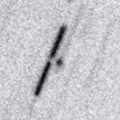
|
Now it is 17.7 mag (Feb. 14, Ken-ichi Kadota). It keeps observable at 18 mag from 2014 to 2015 in the Northern Hemispehre. It is not observable in the Southern Hemispehre.
Date(TT) R.A. (2000) Decl. Delta r Elong. m1 Best Time(A, h)
Mar. 28 14 9.46 71 35.7 4.022 4.369 103 17.9 1:51 (180,-16)
Apr. 4 13 38.05 72 56.7 4.072 4.379 101 18.0 0:53 (180,-18)
|
|
![]()
 19P/Borrelly
19P/Borrelly 6P/d'Arrest
6P/d'Arrest C/2013 US10 ( Catalina )
C/2013 US10 ( Catalina ) C/2013 A1 ( Siding Spring )
C/2013 A1 ( Siding Spring ) C/2015 D1 ( SOHO )
C/2015 D1 ( SOHO ) C/2014 Q1 ( PanSTARRS )
C/2014 Q1 ( PanSTARRS ) 218P/LINEAR
218P/LINEAR C/2012 F3 ( PanSTARRS )
C/2012 F3 ( PanSTARRS ) 29P/Schwassmann-Wachmann 1
29P/Schwassmann-Wachmann 1 C/2012 K1 ( PanSTARRS )
C/2012 K1 ( PanSTARRS ) 22P/Kopff
22P/Kopff C/2014 W11 ( PanSTARRS )
C/2014 W11 ( PanSTARRS ) (3200) Phaethon
(3200) Phaethon 15P/Finlay
15P/Finlay 7P/Pons-Winnecke
7P/Pons-Winnecke 32P/Comas Sola
32P/Comas Sola C/2014 R1 ( Borisov )
C/2014 R1 ( Borisov ) C/2013 C2 ( Tenagra )
C/2013 C2 ( Tenagra ) C/2006 S3 ( LONEOS )
C/2006 S3 ( LONEOS ) C/2014 N3 ( NEOWISE )
C/2014 N3 ( NEOWISE ) C/2011 KP36 ( Spacewatch )
C/2011 KP36 ( Spacewatch ) C/2010 S1 ( LINEAR )
C/2010 S1 ( LINEAR ) C/2014 W9 ( PanSTARRS )
C/2014 W9 ( PanSTARRS ) C/2013 V2 ( Borisov )
C/2013 V2 ( Borisov ) 205P/Giacobini
205P/Giacobini C/2013 X1 ( PanSTARRS )
C/2013 X1 ( PanSTARRS ) C/2015 F4 ( Jacques )
C/2015 F4 ( Jacques ) 116P/Wild 4
116P/Wild 4 C/2013 V4 ( Catalina )
C/2013 V4 ( Catalina ) 110P/Hartley 3
110P/Hartley 3 57P/du Toit-Neujmin-Delporte
57P/du Toit-Neujmin-Delporte 70P/Kojima
70P/Kojima 201P/LONEOS
201P/LONEOS C/2015 F2 ( Polonia )
C/2015 F2 ( Polonia ) 17P/Holmes
17P/Holmes C/2013 G9 ( Tenagra )
C/2013 G9 ( Tenagra ) 269P/2012 R2 ( Jedicke )
269P/2012 R2 ( Jedicke ) P/2014 X1 ( Elenin )
P/2014 X1 ( Elenin ) 40P/Vaisala 1
40P/Vaisala 1 299P/2014 D2 ( Catalina-PanSTARRS )
299P/2014 D2 ( Catalina-PanSTARRS ) 4P/Faye
4P/Faye C/2013 V5 ( Oukaimeden )
C/2013 V5 ( Oukaimeden ) C/2012 K8 ( Lemmon )
C/2012 K8 ( Lemmon ) C/2013 G3 ( PanSTARRS )
C/2013 G3 ( PanSTARRS ) 10P/Tempel 2
10P/Tempel 2 P/2015 F1 ( PanSTARRS )
P/2015 F1 ( PanSTARRS ) 53P/Van Biesbroeck
53P/Van Biesbroeck C/2013 U2 ( Holvorcem )
C/2013 U2 ( Holvorcem ) C/2014 W6 ( Catalina )
C/2014 W6 ( Catalina ) C/2014 Y1 ( PanSTARRS )
C/2014 Y1 ( PanSTARRS ) 65P/Gunn
65P/Gunn 318P/2014 M6 ( McNaught-Hartley )
318P/2014 M6 ( McNaught-Hartley ) C/2014 R4 ( Gibbs )
C/2014 R4 ( Gibbs ) 221P/LINEAR
221P/LINEAR C/2013 TW5 ( Spacewatch )
C/2013 TW5 ( Spacewatch ) (347449) 2012 TW236
(347449) 2012 TW236 C/2014 F2 ( Tenagra )
C/2014 F2 ( Tenagra )![]()



















































